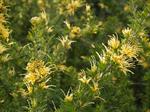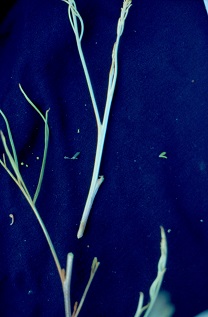
Most grevillea species root readily from semi-hardwood side shoots growing off one year old wood. Most people take nodal cuttings by cutting at right angles immediately below a bud. They will also strike from basal cuttings (cutting through the base of the shoot where it joins the parent branch) as well as from heel cuttings (where a section of bark from the parent plant is pulled off with the cutting). Some would argue that heel cuttings carry a higher risk of fungal infections taking hold at the base of the cutting when planted and the cambium coming away from the stem, so it may be advisable to experiment with different types of cuttings.
Softwood tip cuttings may also be used to propagate grevilleas. Juvenility required for producing softwood cuttings can be achieved through regular annual hard pruning of stock plants in spring. Vegetative shoot growth can be harvested 4-6 weeks after the pruning. Applying a copper-based fungicide spray is recommended 3-4 days after the pruning. Stock plants must also be carefully monitored for sucking or chewing insects which may attack the new vegetative shoots. Softwood tip cuttings may also be harvested from the production cycle. This method is best suited for prostrate and smaller shrub-type forms. Cuttings may also be obtained from stock plants grown in the greenhouse.

Many home gardeners have success with heel cuttings taken about 50-70mm.in length. They use a potting mix of one part sand to one part peat moss (or an environmentally-friendly substitute like coir), and then place them in a cold frame or plastic greenhouse with no bottom heat. It might be worthwhile experimenting with taking cuttings at different times of year if you attempt this. You could try taking stem tip cuttings which include three nodes, and lower stem cuttings between 4 to 6 nodes from the tip.
Commercial growers usually take nodal cuttings with a node at the base with from 1 to 3 nodes on the stem. If the leaves are large half the blade is cut away to reduce plant stress. Often only one mature leaf is left on the stem. Many growers wash their cuttings in sodium hypochlorite and then thoroughly rinse with running water. The cuttings are kept moist by covering them with wet newspaper. The cuttings can then be treated with a root hormone, such as IBA, before planting. The IBA used is often in the powder form which is diluted in a mixture of ethanol and distilled water. The ends of the cuttings are dipped into the solution for several seconds. This treatment helps to promote root formation.
If you wish to attempt propagation of grevilleas, then you'll need to give your cuttings the best possible chance of survival. It is paramount to maintain good hygiene practices in the propagating shed or greenhouse. This involves washing all benches and walls with sodium hypochlorite and removing any plant debris and soil from your work area at the end of each day.
DO YOU WANT TO LEARN MORE ABOUT GREVILLEAS?
CLICK HERE TO SEE OUR GREVILLEA COURSE